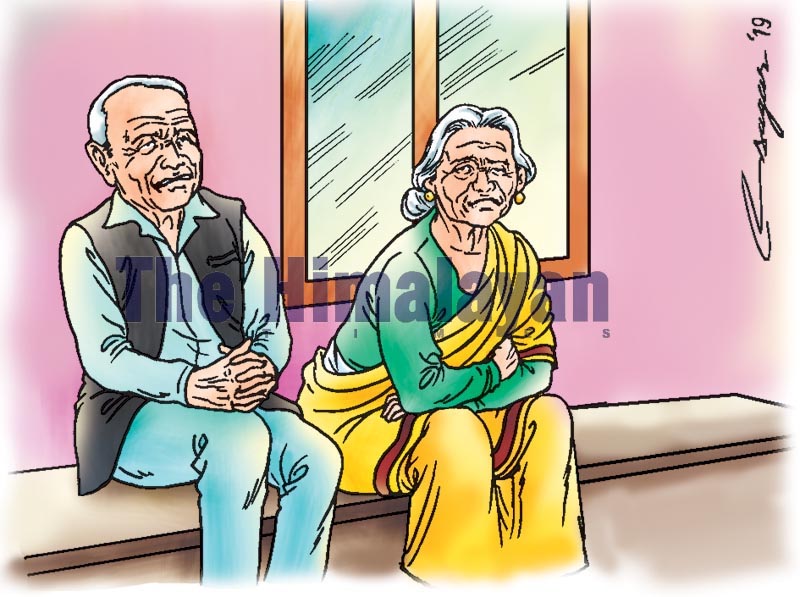Society for the elderly: Could old-age homes be a blessing?
Due to rapid urbanisation, migration and many other reasons, the elderly population is gradually living in isolation with no care and in poor health - an emerging trend in Nepal, across South Asia and globally
Aging has become a global reality impacting various aspects of the society. The advent of globalisation has at one point proved to be a multilayer connecting network for Nepal in the global capital and intellectual market. The provision of a highly advanced mechanism, the ever increasing life-expectancy rate, literacy rate, international exposure and rampant development are the millennial development ideals to facilitate change in the traditional social trend.
However, it is also creating new dynamics in the labour and financial market, demand of goods and services, health and long-term care, support systems, social protection and inter-generational impact. The change in the dynamism has opened up space for non-family experiences, where the family is no longer the centre of an individual’s life, socialisation process, and for the sources of earning.
Traditionally, a joint family was the connecting thread of society. Family members, including elderly members, had a relatively safe space to share their emotions and getting family support when needed.
However, due to rapid urbanisation, migration and many other reasons, society has started to witness family crisis, health crisis, financial crisis, disengagement and disintegration. As a result, the elderly population is gradually living in isolation with little care and poor health - an emerging trend in Nepal, across South Asia and globally.
The hoarding boards of the ever-increasing number of old-age homes in the country signal change in the social and economic structure of Nepal. Life expectancy in Nepal has increased from approximately 27 years in 1951 to 64 years in 2008. There has been a sharp rise in the relative and absolute size of the elderly population in the past four decades.
However, the involvement of non-family institutions has brought change in the traditional form of living, where the elderly population were loved, revered and taken care of. Today the elderly population is found living alone or in an old-age home rather than with the family.
One example of elderly people living alone and in an old-age setting is Devghat. In Devghat, the life of the elderly people has its suitability, normality and extremity. Each individual has a life history, socio-economic background and circumstance, which differ from one another. But the reason for abandoning their previous living state to live a new life in Devghat is seemingly similar, which is isolation, disengagement and financial problems.
By living in the kutis, ashrams or old-aged homes, all elderly people seem to have found the routine of their life in their new habitat. The attraction for opting to live in Devghat is the life of solitude, just like the Mahatmas who find the purpose of living life, security in terms of food and engagement, which were not found in the life of distraught that they lived back home.
In my interview with more than 25 elderly people in Devghat, I found that they had similar life experiences, longing for love, belongingness and acceptance. They are trying to live a life in tune with the waves of the Ganga.
Active ageing, engagement, economy, age-friendly living arrangement and sustainable health are the main concerns of the elderly people in Devghat.
The minimal facilities that consist of one health post, a Rs 3,000 government allowance, three meals a day, gloomy environment and small beds do not cover the need of the body, which is now not functioning well physically, mentally, socially and emotionally. Most of them need support in their daily life.
Most of them said that, it was the call of the time that pushed them or pulled them towards Devghat. One of the pull factors was the religious connotation of mokshya, peace and illusion of home in Devghat.
The aesthetic and religious benevolence has given life and a direction to the old-age people in Devghat. However, many of them were afraid to die alone or to undergo a painful and long death with no loved ones on the side.
This shows the change in our social context, where once the family was the institution of love, care and support. This certainly calls for an alternative course of action that focusses on the well-being of the elderly population of the country.
With old age comes social, economic, physical and emotional change, which alters the life of independence that they once lived. It becomes more difficult to perform the activities of daily life.
There is a need of a caretaker, or social support network, one who understands the need of the elderly people, be it at home or in an institutional setting. If the changing time calls for a change in the living context, then it should opt for it in accordance with the needs of the elderly population.
Healthy active ageing, isolation of the aged population and ageism are now the main concerns around ageing in Nepal. More understanding of old-age will bring the issues of the elderly into mainstream discourse for developing sustainable and equitable health systems and an age-friendly environment for elderly people.
The current sociological trends are irreversible, so is ageing. With the old-age homes, they might not have the support of the loved ones, but they have the support of each other. We all die alone, but it’s better to die with someone by our side.






